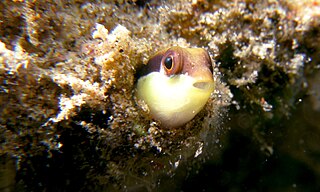Pseudoplesiops wassi, the fleckfin dottyback or Wass's dottyback, is a species of dottyback fish. It is found associated with coral reefs and other rocky coastal habitats in a large part of the south-western Pacific including the Great Barrier Reef, the Coral Sea, the Caroline Islands, the Bismarck Archipelago, Vanuatu, Fiji, Rotuma, Tonga, Samoa, and the Solomon Islands. The specific name honours the fisheries biologist Richard C. Wass.

Assiculus is a genus of fish in the "dottyback" family Pseudochromidae. It is monotypic, containing only Assiculus punctatus. It is a small species of dottyback which is covered in small, bright blue spots. The males are bluish in colour while the females are greenish-yellow and are smaller than the males. A. punctatus is found in coastal areas in the vicinity of reefs and weedy areas; normally in rather turbid waters as deep as 30 metres (98 ft). This secretive species frequents areas where there are highly eroded limestone reefs and rocks.

The royal dottyback, also called the bicolor dottyback or false gramma is a fish commonly kept in marine aquariums. The front of the fish is bright purple and the posterior is yellow. In an aquarium, it will grow up to three inches long. The dottyback will defend its territory against fish several times its size, but gets along with many other common aquarium fish. This is sometimes mistaken for a royal gramma.

Pseudochromis sankeyi, the striped dottyback, is a species of ray-finned fish from the Western Indian Ocean which is a member of the family Pseudochromidae. It occasionally makes its way into the aquarium trade. It grows to a size of 7 cm in length. The specific name honours the British collector and wholesaler of marine fish Richard D. Sankey, who gave Roger Lubbock study specimens.
Manonichthys alleni, the Sabah dottyback is a species of ray-finned fish from the family Pseudochromidae, the dottybacks. It occasionally makes its way into the aquarium trade. It grows to a size of 12 centimetres (4.7 in) in length. This dottyback has only been known from Indonesia and Malaysia, but was recently recorded in the Davao Gulf in the southern Philippines. The specific name honours the ichthyologist Gerald R. Allen of the Western Australian Museum in Perth who collected the type specimen and provided photographs of this species which Gill used in his description, as well as being in recognition of Allen's contribution to the knowledge of Indo-Pacific fish and of the support Allen gave Gill in is work on the Pseudochromidae.
Natalichthys is a genus of ray-finned fishes, classified under the subfamily Congrogadinae, the eel blennies, part of the dottyback family, Pseudochromidae. They are found in the western Indian Ocean off the eastern coast of South Africa, the genus being named after Natal, where all three species in the genus are so far restricted to.
Rusichthys is a genus of ray-finned fishes, classified under the subfamily Congrogadinae, the eel blennies, part of the dottyback family, Pseudochromidae, from the western Indian Ocean. The generic name is a compound of the acronym RUSI which stands for Rhodes University Smith Institute and thus honours the South African ichthyologist James Leonard Brierley Smith

Manonichthys is a genus of ray-finned fishes from the subfamily Pseudochrominae, which is one of four subfamilies in the dottyback family Pseudochromidae. They are found in the tropical eastern Indian Ocean and the western Pacific Ocean. Many of the species of Manonichthys live within the bodies of large sponges, the genus name references the Greek word for a kind of sponge, manon, in combination with the Greek word for "fish", ichthys.

Ogilbyina is a genus of ray-finned fishes from the subfamily Pseudochrominae, which is one of four subfamilies in the dottyback family Pseudochromidae. They are found in the tropical western Pacific Ocean. The genus name honours the zoologist James Douglas Ogilby (1853-1925) of the Queensland Museum.
Pseudoplesiopinae is a subfamily of the family Pseudochromidae, the dottybacks, it consists of small species of coral-reef inhabiting fish which are distributed throughout the Indo-Pacific.
The bugeye dottyback, also known as Knight's dottyback, is a species of ray-finned fish, the only species in the monospecific genus Amsichthys, belonging to the subfamily Pseudoplesiopinae, of the family Pseudochromidae. It is found in the Indo-Pacific region.
Chlidichthys is a genus of ray-finned fishes from the western and central Indian Ocean, it is part of the subfamily Pseudoplesiopinae which in turn is a constituent subfamily of the dottyback family, the Pseudochromidae. Within the Pseudoplesiopinae, Chlidichthys is regarded as a sister taxon to Pectinochromis.
Lubbockichthys is a genus of ray-finned fish from the Indo-Pacific region which belongs to the subfamily Pseudoplesiopinae, part of the family Pseudochromidae, the dottybacks. The species in this genus have small cycloid scales throughout their lives; some of their head bones have a weakly honeycombed surface; and the parietal bone encloses the rear section of the supratemporal laterosensory canal.
St Brandon's Dottyback Chlidichthys abruptus is a species of fish in the family Pseudochromidae.
Chlidichthys smithae is a species of fish in the family Pseudochromidae.
The Cerise Dottyback Chlidichthys johnvoelckeri is a species of fish in the family Pseudochromidae.
The Chagos Dottyback Chlidichthys chagosensis is a species of fish in the family Pseudochromidae.
The Chainmail Dottyback Chlidichthys clibanarius is a species of fish in the family Pseudochromidae.
The Fody Dottyback Chlidichthys foudioides is a species of fish in the family Pseudochromidae.
Lubbockichthys myersi, the dottyback, is a species of fish in the family Pseudochromidae.




